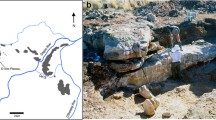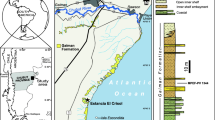Abstract
Two new unequivocal stagodontids, Fumodelphodon pulveris, gen. et. sp. nov., and Hoodootherium praeceps, gen. et. sp. nov., are described from the Turonian (~92 Ma) Smoky Hollow Member of the Straight Cliffs Formation, of southern Utah, USA. Mammals from this time period are poorly represented; the recovery of these two large stagodontids demonstrates the early emergence of faunal elements mostly associated with the later Cretaceous. These taxa represent the earliest stagodontids with crushing premolars (Fumodelphodon) and sectorial premolars (Hoodootherium), morphologically similar to the well-known stagodontids Didelphodon and Eodelphis, respectively. The similar morphologies suggest that these two new genera may be early members of later Cretaceous stagodontid clades, implying a ~ 7 Ma ghost lineage leading to Eodelphis and a ~ 15 Ma ghost lineage to Didelphodon. A reexamination of stagodontid characters suggests a basal placement of Pariadens within Stagodontidae, contrary to some recent studies. The discovery of two new stagodontids bearing lower molars morphologically similar to, but premolars distinct from, Eodelphis highlights the importance of the specialized premolar morphology for resolving the relationships between genera within Stagodontidae.





Similar content being viewed by others
References
Cifelli RL (1990a) Cretaceous mammals of southern Utah III. Therian mammals from the Turonian (early Late Cretaceous). J Vertebr Paleontol 10(3): 332–345
Cifelli RL (1990b) Cretaceous mammals of southern Utah I. Marsupials from the Kaiparowits Formation (Judithian). J Vertebr Paleontol 10(3): 295–319
Cifelli RL (1993) Early Cretaceous mammal from North America and the evolution of marsupial dental characters. Proc Natl Acad Sci USA 90: 9413–9416
Cifelli RL (1996) Application of fitted polynomial functions to modeling contours derived from mammalian mandibular and dental morphology. Am Midl Nat 136(2): 367–384
Cifelli RL (2004) Marsupial mammals from the Albian-Cenomanian (Early-Late Cretaceous) boundary, Utah. Bull Am Mus Nat Hist 285: 62–79
Cifelli RL, Davis BM (2015) Tribosphenic mammals from the Lower Cretaceous Cloverly Formation of Montana and Wyoming. J Vertebr Paleontol: e920848. doi: 10.1080/02724634.2014.920848
Cifelli RL, Eaton JG (1987) Marsupial from the earliest Late Cretaceous of western US. Nature 325: 520–522
Cifelli RL, Cohen JE, Davis BM (2016) New tribosphenic mammals from the Mussentuchit local Fauna (Cedar Mountain Formation, Cenomanian), Utah, USA. Palaeontol Pol 67: 67–81. doi: 10.4202/pp.2016.67_067
Clemens WA (1966) Fossil mammals of the type Lance Formation Wyoming, part II. Marsupialia. Publ Geol Sci Univ Calif 62: 1–122
Clemens WA (1968) A mandible of Didelphodon vorax (Marsupialia, Mammalia). Los Angeles County Mus Contrib Sci 133: 1–11
Clemens WA (1973) Fossil mammals of the type Lance Formation Wyoming, part III. Eutheria and summary. Publ Geol Sci Univ Calif 94: 1–102
Clemens WA (1979) Marsupialia. In: Lillegraven JA, Kielan-Jaworowska Z, Clemens WA (eds) Mesozoic Mammals: the First Two-thirds of Mammalian History. University of California Press, Berkeley, pp 192–220
Constantino PJ, Lee JJ, Morris D, Lucas PW, Hartstone-Rose A, Lee WK, Dominy NJ, Cunnignham A, Wagner M, Lawn BR (2011) Adaptation to hard-object feeding in sea otters and hominins. J Hum Evol 61(1): 89–96. doi: 10.1016/j.jhevol.2011.02.009
Davis BM, Cifelli RL, Cohen JE (2016) First fossil mammals from the Upper Cretaceous Eagle Formation (Santonian, northern Montana, USA), and mammal diversity during the Aquilan North American land mammal age. Palaeontol Pol 67: 101–126. doi: 10.4202/pp.2016.67_101
Eaton JG (1987) The Campanian-Maastrichtian boundary in the western interior of North America. Newsl Stratigr 18(1): 31–39
Eaton JG (1991) Biostratigraphic framework for the Upper Cretaceous rocks of the Kaiparowits Plateau, southern Utah. Geol Soc Am Special Papers 260: 47–64
Eaton JG (1993) Therian mammals from the Cenomanian (Upper Cretaceous) Dakota Formation, southwestern Utah. J Vertebr Paleontol 13(1): 105–124
Eaton JG (2006) Santonian (Late Cretaceous) mammals from the John Henry member of the Straight Cliffs Formation, Grand Staircase-Escalante National Monument, Utah. J Vertebr Paleontol 26: 446–460
Eaton JG (2009) Cenomanian (Late Cretaceous) mammals from Cedar Canyon, southwest Utah, and a revision of Cenomanian Alphadon-like marsupials. Mus No Ariz Bull 65: 97–110
Eaton JG, Cifelli RL (2013) Review of Late Cretaceous mammalian faunas of the Kaiparowits and Paunsaugunt plateaus, southwestern Utah. In: Titus AL, Loewen MA (eds) At the Top of the Grand Staircase. Indiana University Press, Bloomington, pp 319–328
Evans AR, Sanson GD (2003) The tooth of perfection: functional and spatial constraints on mammalian tooth shape. Biol J Linn Soc 78: 173–191
Ewer RF (1954) XXXI.—some adaptive features in the dentition of hyaenas. Ann Mag Nat Hist 7(75): 188–194
Fox RC (1968) Early Campanian (Late Cretaceous) mammals from Alberta, Canada. Nature 220: 1046
Fox RC (1971) Marsupial mammals from the Early Campanian Milk River Formation, Alberta, Canada. Zool J Linn Soc 50: 145–164
Fox RC (1972) A primitive therian mammal from the Upper Cretaceous of Alberta. Can J Earth Sci 9(11): 1479–1494
Fox RC (1976) Additions to the mammalian local fauna from the Upper Milk River Formation (Upper Cretaceous), Alberta. Can J Earth Sci 13: 1105–1118
Fox RC (1981) Mammals from the Upper Cretaceous Oldman Formation, Alberta. V. Eodelphis Matthew, and the evolution of the Stagodontidae (Marsupialia). Can J Earth Sci 18: 350–365
Fox RC (1984) Paranyctoides maleficus (new species), an early eutherian mammal from the Cretaceous of Alberta. Spec Publ Carnegie Mus Nat Hist 9: 9–20
Fox RC, Naylor BG (1986) A new species of Didelphodon Marsh (Marsupialia) from the Upper Cretaceous of Alberta, Canada: paleobiology and phylogeny. Neues Jahrb Geol P–A 172(3): 357–380
Fox RC, Naylor BG (2006) Stagodontid marsupials from the Late Cretaceous of Canada and their systematic and functional implications. Acta Palaeontol Pol 51(1): 13–36
Grieco TM, Rizk OT, Hlusko LJ (2013) A modular framework characterizes micro- and macroevolution of Old World monkey dentitions. Evolution 67(1): 241–259. doi: 10.1111/j.1558-5646.2012.01757.x
Kelly TS (2014) Preliminary report on the mammals from the Lane's Little Jaw Site quarry: a latest Cretaceous (earliest Puercan?) local fauna, Hell Creek Formation, southeastern Montana. Paludicola 10(1): 50–91
Kielan-Jaworowska Z, Cifelli RL, Luo Z-X (2004) Mammals from the Age of Dinosaurs: Origins, Evolution, and Structure. Columbia University Press, New York, 630 pp
Kovacs I (1971) A systematic description of dental roots. In: Dahlberg AA(ed) Dental Morphology and Evolution. University of Chicago Press, Chicago, pp 211–256
Kupczik K, Stynder DD (2012) Tooth root morphology as an indicator for dietary specialization in carnivores (Mammalia: Carnivora). Biol J Linn Soc 105: 456–471
Lillegraven JA (1969) Latest Cretaceous mammals of upper part of Edmonton Formation of Alberta, Canada and review of marsupial-placental dichotomy in mammalian evolution. Univ Kansas Paleontol Contrib Art 50 (Vertebrata 12): 1–122
Lillegraven JA, McKenna MC (1986) Fossil mammals from the "Mesaverde" Formation (Late Cretaceous, Judithian) of the Bighorn and Wind River basins, Wyoming, with definitions of Late Cretaceous North American land-mammal "ages." Am Mus Novitates 2840: 1–68
Linnaeus C (1758) Systema naturae per regna tria naturae, secundum classes, ordines, genera, species, cun characteribus, differentiis, synonymis, locis. Vol. 1: Regnum animale. Editio decima, reformata. Laurentii Salvii, Stockholm
Lofgren DL (1992) Upper premolar configuration of Didelphodon vorax (Mammalia, Marsupialia, Stagodontidae). J Paleontol 66(1): 162–164
MacLarnon AM (1989) Applications of the reflex instruments in quantitative morphology. Folia primatol 53: 33–49
Marsh OC (1889) Discovery of Cretaceous Mammalia. Part II. Am J Sci 38(3): 177–180
Peterson F (1969) Four new members of the Upper Cretaceous Straight Cliffs Formation in the southeastern Kaiparowits region Kane County, Utah. Geological Survey Bulletin 1274
Rizk OT, Grieco TM, Holmes MW, Hlusko LJ (2013) Using geometric morphometrics to study the mechanisms that pattern primate dental variation. In: Scott GR, Irish JD (eds) Anthropological Perspectives on Tooth Morphology: Genetics, Evolution, Variation. Cambridge University Press, Cambridge, 582 pp
Rougier GW, Davis BM, Novacek MJ (2015) A deltatheroidan mammal from the Upper Cretaceous Baynshiree Formation, eastern Mongolia. Cretaceous Res 52: 167–177. doi: 10.1016/j.cretres.2014.09.009
Rougier GW, Wible JR, Novacek MJ (1998) Implications of deltatheridium specimens for early marsupial history. Nature 396: 459–463
Rougier GW, Wible JR, Novacek MJ (2004) New specimen of Deltatheroides cretacicus (Metatheria, Deltatheroida) from the Late Cretaceous of Mongolia. Bull Carnegie Mus Nat Hist 36: 245–266
Scott CS, Fox RC (2015) Review of Stagodontidae (Mammalia, Marsupialia) from the Judithian (Late Cretaceous) Belly River group of southeastern Alberta, Canada. Can J Earth Sci 52(8): 682–695. doi: 10.1139/cjes-2014-0170
Titus AL, Roberts EM, Albright LB (2013) Geologic overview. In: Titus AL, Loewen MA (eds) At the Top of the Grand Staircase. Indiana University Press, Bloomington, pp 13–41
Trinkel M (2010) Prey selection and prey preferences of spotted hyenas Crocuta crocuta in the Etosha National Park, Namibia. Ecol Res 25(2): 413–417. doi: 10.1007/s11284-009-0669-3
Van Valkenburgh B (1988) Incidence of tooth breakage among large, predatory mammals. Am Nat 131(2): 291–302
Van Valkenburgh B (2009) Costs of carnivory: tooth fracture in Pleistocene and recent carnivorans. Biol J Linn Soc 96: 68–81
Vullo R, Gheerbrant E, Muizon C de, Néraudeau D (2009) The oldest modern therian mammal from Europe and its bearing on stem marsupial paleobiogeography. Proc Natl Acad Sci USA 106(47): 19910–19915
Wilson GP (2013) Mammals across the K/Pg boundary in northeastern Montana, U.S.A: dental morphology and body-size patterns reveal extinction selectivity and immigrant-fueled ecospace filling. Paleobiology 39(3): 429–469
Wilson GP, Ekdale EG, Hoganson JW, Calede JJ, Vander Linden A (2016) A large carnivorous mammal from the Late Cretaceous and the North American origin of marsupials. Nature Communications 7: 13734. doi: 10.1038/ncomms13734
Young RG (1960) Dakota group of Colorado plateau. Bull Am Assoc Petroleum Geol 44(2): 156–194
Acknowledgements
I am grateful to Rich Cifelli for helpful discussions and comments on the project, Nick Czaplewski for help with the illustrations, and Steve Westrop, Guillermo Rougier, and Joe Frederickson for advice on the phylogenetic analysis. I would like to thank Alan Titus and Scott Foss of the Bureau of Land Management for access to the field area and permission to collect fossils on Federal lands. Support for this project was provided by grants to Rich Cifelli from the National Geographic Society (2881-84), the National Science Foundation (BSR 8507598, 8796225, 8906992, DEB 9401994), and the Petroleum Research Fund of the American Chemical Society (20311-G8). Lastly, I would like to thank Brian Davis and Jeff Eaton for helpful comments on a previous version of this manuscript.
Author information
Authors and Affiliations
Corresponding author
Electronic supplementary material
ESM 1
(DOCX 77.8 kb)
Rights and permissions
About this article
Cite this article
Cohen, J.E. Earliest Divergence of Stagodontid (Mammalia: Marsupialiformes) Feeding Strategies from the Late Cretaceous (Turonian) of North America. J Mammal Evol 25, 165–177 (2018). https://doi.org/10.1007/s10914-017-9382-0
Published:
Issue Date:
DOI: https://doi.org/10.1007/s10914-017-9382-0




